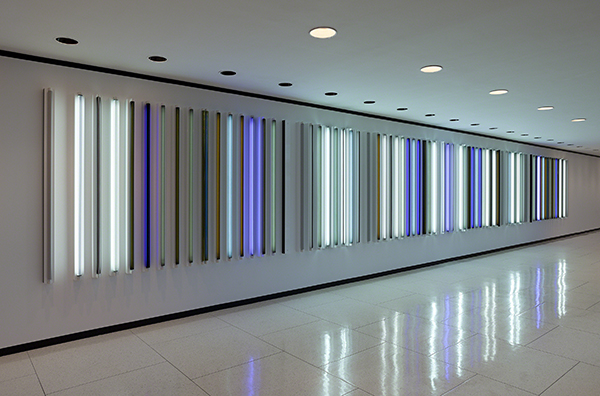Space-Motion-Light: Robert Irwin
September 12th is the birthday of artist Robert Irwin, whose spectacular artistic career has spanned numerous art forms and styles through the years. His light installations are usually based on the location in which they are installed, such as this beautiful work installed at the Albright-Knox Art Gallery in Buffalo, New York, near Niagara Falls. This piece is a brilliant interpretation of water through fluorescent lighting.
 |
| Robert Irwin (born 1928, U.S.), NIAGARA, 2012. Fluorescent lamps, electrical tape, colored gels, 6' x 45' x 4 ¾" (182.9 x 1390.7 x 12.1 cm). Albright-Knox Art Gallery, Buffalo, NY. © 2022 Robert Irwin/Artists Rights Society (ARS), New York. (AK-3129irars) |
Irwin's early fluorescent light installations were interpretations of Minimalist painting and explorations of color relationships. By the 1990s, Irwin realized that the scope of his fluorescent works had the capacity to be large-scale abstract paintings in light. Irwin’s use of fluorescent light transcends installation to become relational aesthetics akin to Op Art. His installations are site-specific, using the regional surroundings as the key to the palette of fluorescent colors, such as this rendition in celebration of Niagara Falls in Buffalo.
The use of light in or as a work of art has been explored since early in the 1900s. Light was usually used in limited ways where devices were programmed to produce shifting patterns of colored light. These experiments originated at Bauhaus during the 1920s in the motion and light experiments of László Moholy-Nagy (1895–1946).
In the U.S., the inventor of the color organ, Thomas Wilfred (1889–1968), created early experimental combinations of light and color. The late 1960s saw a revival of interest in the use of light as a stand-alone medium, a logical result of its inclusion as a component in installations, performances, and videos combined with action and sound.
Born in Long Beach, California, Irwin became a pioneer in the genre of Light-Space-Motion art. Between 1948 and 1950 he studied art at Otis Art Institute, followed by studies at Jepson Art Institute in 1951 and the Chouinard Art Institute in Los Angeles from 1952 to 1954. Between 1958 and 1970, he produced abstract paintings, first in an Abstract Expressionist aesthetic and later in Minimalism. In 1970, he decided to turn toward installation, primarily fluorescent light, in order to expand the scope of his artistic ideas.


Comments